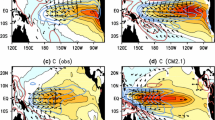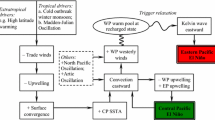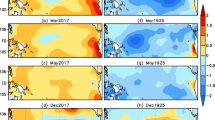Abstract
El Niño events display a large diversity in terms of spatial pattern, temporal evolution, and amplitude, which may change over time due to climate change or internal variability. We used the Extended Reconstructed Sea Surface Temperature (SST), version 5 (ERSSTv5) dataset and applied a nonlinear K-means cluster analysis to the evolution of SST anomalies in the equatorial Pacific for 33 El Niño years from 1901 to 2020. Based on the analysis of the spatio-temporal evolution of El Niño events, we identified 4 types of El Niño, which include basin-wide, eastern Pacific (EP), central Pacific (CP), and successive El Niño. EP and CP El Niño events are weaker and terminate faster than basin-wide El Niño, whereas successive El Niño events are often (83\(\%\)) followed by a La Niña event. The frequency of basin-wide and particularly CP El Niño events has started to increase since the mid-1950s, while a gradual decrease in the frequency of both EP and successive El Niño is identified during the study period. We have analyzed the linkage between the identified 4 types of El Niño and the Indian Ocean Dipole (IOD). A statistically significant positive correlation is found between basin-wide El Niño and the IOD in boreal autumn, implying that a developing basin-wide El Niño generally can trigger a positive IOD in boreal autumn. Our results have important implications for a better understanding of interdecadal changes in the type of El Niño events and provide a framework to improve the predictability of the IOD.







Similar content being viewed by others
Availability of data and materials
We obtained the ERSSTv5 data from https://psl.noaa.gov/data/gridded/data.noaa.ersst.v5.html.
Code availability
The datasets generated during and/or analyzed during the current study are available from the corresponding author on reasonable request
References
Alizadeh O (2022) Amplitude, duration, variability, and seasonal frequency analysis of the El Niño-Southern Oscillation. Clim Change 174:20
Alizadeh O, Qadimi M, Zolghadrshojaee M, Irannejad P (2022) Frequency of different types of El Niño events under global warming. Int J Climatol 42:9697–9709
Alizadeh-Choobari O (2017) Contrasting global teleconnection features of the eastern Pacific and central Pacific El Niño events. Dyn Atmos Oceans 80:139–154
Alizadeh-Choobari O, Najafi MS (2018) Climate variability in Iran in response to the diversity of the El Niño-Southern Oscillation. Int J Climatol 38:4239–4250
Alizadeh-Choobari O, Adibi P, Irannejad P (2018) Impact of the El Niño-Southern Oscillation on the climate of Iran using ERA-Interim data. Clim Dyn 51:2897–2911
Annamalai H, Xie SP, McCreary JP, Murtugudde R (2005) Impact of Indian Ocean sea surface temperature on developing El Niño. J Clim 18:302–319
Ashok STPK, Swapna P, Murtugudde RG (2012) Is a global warming signature emerging in the tropical Pacific? Geophys Res Lett 39:L02,701
Bjerknes J (1969) Atmospheric teleconnections from the equatorial Pacific. Mon Wea Rev 97:163–172
Capotondi A, Wittenberg AT, Newmaman M, Lorenzo ED, Yu JY, Braconnot P, Cole J, Dewitte B, Giese B, Guilyardi E, Jin FF, Karnauskas K, Kirtman B, Lee T, Schneider N, Xue Y, Yeh SW (2015) Understanding ENSO diversity. Bull Am Meteorol Soc 96:921–938
Capotondi A, Wittenberg AT, Kug TK J S, McPhaden MJ (2020) ENSO diversity. In Santoso A, McPhaden M Cai W (eds) El Niño Southern Oscillation in a changing climate. Geophysical Monograph Series pp 65–86 Washington, DC: American Geophysical Union ISBN: 978-1-119-54812-6
Chen D, Lian T, Fu C, Cane MA, Tang Y, Murtugudde R, Song X, Wu Q, Zhou L (2015) Strong influence of westerly wind bursts on El Niño diversity. Nat Geosci 8:339–345
Choi J, An SI, Kug JS, Yeh SW (2011) The role of mean state on changes in El Niño’s flavor. Clim Dyn 37:1205–1215
Chung PH, Li T (2013) Interdecadal relationship between the mean state and El Niño type. J Clim 26:361–379
Freund MB, Henley BJ, Karoly DJ, McGregor HV, Abram NJ, Dommenget D (2019) Higher frequency of Central Pacific El Niño events in recent decades relative to past centuries. Nat Geosci 12:450–455
Garreaud RD (2018) A plausible atmospheric trigger for the 2017 coastal El Niño. Int J Climatol 38:e1296–e31,302
Hu H, Wu Q, Wu Z (2018) Influences of two types of El Niño event on the Northwest Pacific and tropical Indian Ocean SST anomalies. J Oceanology Limnology 36:33–47
Hu S, Fedorov AV (2018) Cross-equatorial winds control El Niño diversity and change. Nat Clim Change 8:792–802
Huang B, Thorne PW, Banzon VF, Boyer T, Chepurin G, Lawrimore JH, Menne MJ, Smith TM, Vose RS, Zhang HM (2017) Extended Reconstructed Sea Surface Temperature, Version 5 (ERSSTv5): Upgrades, validations, and intercomparisons. J Clim 30:8179–8205
Huang B, L’Heureux M, Hu ZZ, Yin X, Zhang HM (2020) How significant was the 1877/78 El Niño? J Clim 33:4853–4869
Jadhav J, Panickal S, Marathe S, Ashok K (2015) On the possible cause of distinct El Niño types in the recent decades. Sci Rep 5(17):009
Jeong HI, Ahn JB (2017) A new method to classify ENSO events into eastern and central Pacific types. Int J Climatol 37:2193–2199
Jin FF, Kim ST, Bejarano LA (2006) A coupled-stability index for ENSO. Geophys Res Lett 33(L23):708
Kao HY, Yu JY (2009) Contrasting eastern-Pacific and central-Pacific types of ENSO. J Clim 22:615–632
Kaplan A, Cane MA, Kushnir Y, Clement AC, Blumenthal MB, Rajagopalan B (1998) Analyses of global sea surface temperature 1856-1991. J Geophys Res: Oceans 103:18,567–18,589
Kaufman L, Rousseeuw PJ (2009) Finding groups in data: An introduction to cluster analysis. John Wiley & Sons, New York
Kug JS, Ham YG (2011) Are there two types of La Niña? Geophys Res Lett 38(L16):704
Kug JS, Jin FF, An SI (2009) Two types of El Niño events: Cold tongue El Niño and warm pool El Niño. J Clim 22:1499–1515
Kumar KK, Rajagopalan B, Hoerling M, Bates G, Cane M (2006) Unraveling the mystery of Indian monsoon failure during El Niño. Science 314:115–119
Larkin NK, Harrison DE (2005) Global seasonal temperature and precipitation anomalies during El Niño autumn and winter. Geophys Res Lett 32(L16):705
Le T, Ha KJ, Bae DH, Kim SH (2020) Causal effects of Indian Ocean Dipole on El Niño-Southern Oscillation during 1950-2014 based on high-resolution models and reanalysis data. Environ Res Lett 15:1040b6
Lee T, McPhaden MJ (2010) Increasing intensity of El Niño in the central-equatorial Pacific. Geophys Res Lett 37(L14):603
Lengaigne M, Boulanger JP, Menkes C, Spencer H (2006) Influence of the seasonal cycle on the termination of El Niño events in a coupled general circulation model. J Clim 19:1850–1868
Lübbecke J, McPhaden MJ (2014) Assessing the twenty-first-century shift in ENSO variability in terms of the Bjerknes stability index. J Clim 27:2577–2587
McPhaden MJ, Lee T, McClurg D (2011) El Niño and its relationship to changing background conditions in the tropical Pacific. Geophys Res Lett 38(L15):709
Newman M, Alexander MA, Ault TR, Cobb KM, Deser C, Lorenzo ED, Mantua NJ, Miller AJ, Minobe S, Nakamura H, Schneider N, Vimont DJ, Phillips AS, Scott JD, Smith CA (2016) The Pacific Decadal Oscillation, revisited. J Clim 29:4399–4427
Qadimi M, Alizadeh O, Irannejad P (2021) Impacts of the El Niño-Southern Oscillation on the strength and duration of the Indian summer monsoon. Meteorol Atmos Phys 133:553–564
Rasmusson EM, Carpenter TH (1982) Variations in tropical sea surface temperature and surface wind fields associated with the Southern Oscillation/El Niño. Mon Weather Rev 110:354–384
Ren HL, Jin FF (2011) Niño indices for two types of ENSO. Geophys Res Lett 38(L04):704
Ren HL, Wang R (2020) Distinctgrowth rates of the two ENSO types. Geophys Res Lett 47:e2020GL088,179
Ren HL, Wang R (2023) Diagnosing the linear periodicity dynamics of ENSO for its two spatiotemporal modes. Geophys Res Lett 50:e2023GL105,756
Ren HL, Lu B, Wan J, Tian B, Zhang P (2018) Identification standard for ENSO events and its application to climate monitoring and prediction in China. J Meteorol Res 32:923–936
Ren HL, Scaife AA, Dunstone N, Tian B, Liu Y, Ineson S, Lee JY, Smith D, Liu C, Thompson V, Vellinga M, MacLachlan C (2019) Seasonal predictability of winter ENSO types in operational dynamical model predictions. Clim Dyn 52:3869–3890
Reynolds RW, Smith TM (1994) Improved global sea surface temperature analyses using optimum interpolation. J Clim 7:929–948
Sahastrabuddhe R, Ghausi SA, Joseph J, Ghosh S (2023) Indian Summer Monsoon Rainfall in a changing climate: a review. J Water Clim Change 14:1061–1088
Saji NH, Goswami BN, Vinayachandran PN, Yamagata T (1999) A dipole in the tropical Indian Ocean. Nature 401:360–363
Takahashi K, Martinez AG (2019) The very strong coastal El Niño in 1925 in the far-eastern Pacific. Clim Dyn 52:7389–7415
Timmermann A, An SI, Kug JS, Jin FF, Cai W, Capotondi A, Cobb K, Lengaigne M, McPhaden MJ, Stuecker MF, Stein K, Wittenberg AT, Yun KS, Bayr T, Chen HC, Chikamoto Y, Dewitte B, Dommenget D, Grothe P, Guilyardi E, Ham YG, Hayashi M, Ineson S, Kang D, Kim S, Kim W, Lee JY, Li T, Luo JJ, McGregor S, Planton Y, Power S, Rashid H, Ren HL, Santoso A, Takahashi K, Todd A, Wang G, Wang G, Xie R, Yang WH, Yeh SW, Yoon J, Zeller E, Zhang X (2018) El Niño-Southern Oscillation complexity. Nature 559:535–545
Wang B, Luo X, Yang YM, Sun W, Cane MA, Cai W, Yeh SW, Liu J (2019) Historical change of El Niño properties sheds light on future changes of extreme El Niño. Proc Natl Acad Sci USA 116:22,512–22,517
Wang G, Hendon HH (2007) Sensitivity of Australian rainfall to inter-El Niño variations. J Clim 20:4211–4226
Wang R, Ren HL (2020) Understanding key roles of two ENSO modes in spatiotemporal diversity of ENSO. J Clim 33:6453–6469
Webster PJ, Moore AM, Loschnigg JP, Leben RR (1999) Coupled ocean-atmosphere dynamics in the Indian Ocean during 1997–98. Nature 401:356–360
Wyrtki K (1975) El Niño: The dynamic response of the equatorial Pacific Ocean to atmospheric forcing. J Phys Oceanogr 5:572–594
Yeh SW, Kug JS, An SI (2014) Recent progress on two types of El Niño: Observations, dynamics, and future changes. Asia-Pac J Atmos Sci 50:69–81
Yeh SW, Cai W, Min SK, McPhaden MJ, Dommenget D, Dewitte B, Collins M, Ashok K, An SI, Yim BY, Kug JS (2018) ENSO atmospheric teleconnections and their response to greenhouse gas forcing. Rev Geophys 56:185–206
Yu JY, Kim ST (2013) Identifying the types of major El Niño events since 1870. Int J Climatol 33:2105–2112
Yu JY, Kao PK, Paek H, Hsu HH, Hung CW, Lu MM, An SI (2015) Linking emergence of the Central Pacific El Niño to the Atlantic Multidecadal Oscillation. J Clim 28:651–662
Zhang L, Han W, Hu ZZ (2021) Interbasin and multiple-time-scale interactions in generating the 2019 extreme Indian Ocean Dipole. J Clim 34:4553–4566
Zhang W, Wang Y, Jin FF, Stuecker MF, Turner AG (2015) Impact of different El Niño types on the El Niño/IOD relationship. Geophys Res Lett 42:8570–8576
Funding
This work has been financially supported by Iran National Science Foundation (INSF) under grant number 4014209.
Author information
Authors and Affiliations
Contributions
Omid Alizadeh: conceptualization, investigation, methodology, formal analysis, writing the initial and final draft, review and editing Morteza Qadimi: conceptualization, investigation, methodology, visualization
Corresponding author
Ethics declarations
Conflict of interest/Competing interests
The authors declare no competing interests.
Ethics approval
Not applicable
Consent to participate
Not applicable
Consent for publication
The authors consent to the publication of the manuscript, should the article be accepted by the Editor-in-chief upon completion of the refereeing process.
Additional information
Publisher's Note
Springer Nature remains neutral with regard to jurisdictional claims in published maps and institutional affiliations.
Rights and permissions
Springer Nature or its licensor (e.g. a society or other partner) holds exclusive rights to this article under a publishing agreement with the author(s) or other rightsholder(s); author self-archiving of the accepted manuscript version of this article is solely governed by the terms of such publishing agreement and applicable law.
About this article
Cite this article
Alizadeh, O., Qadimi, M. El Niño flavors, their interdecadal changes, and impacts on the Indian Ocean Dipole pattern. Theor Appl Climatol (2024). https://doi.org/10.1007/s00704-024-04978-8
Received:
Accepted:
Published:
DOI: https://doi.org/10.1007/s00704-024-04978-8




